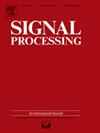A similarity-guided block-structured dictionary learning method for fault feature extraction of rolling bearings
IF 3.4
2区 工程技术
Q2 ENGINEERING, ELECTRICAL & ELECTRONIC
引用次数: 0
Abstract
Periodical impulses generated by locally damaged bearings are frequently drowned out by harmonics and noise interference, making it challenging to accurately detect rolling bearing faults. Dictionary learning-based sparse representation provides an effective way to accurately recover fault impulses from noisy signals. However, current dictionary learning algorithms still have some deficiencies, such as low computational efficiency and insufficient accuracy of signal reconstruction. How to obtain an overcomplete dictionary whose atoms match the fault features and have low coherence between atoms is still an open problem. Therefore, a sparse representation method via similarity-guided block-structured dictionary learning is investigated to extract periodic impulse features for fault detection of rolling bearings. First, an initial signal matrix is constructed by performing period segmentation and cyclic shift operations on the original signal, and then the harmonics are eliminated column by column by least square trend estimation algorithm. Secondly, a block-structured dictionary learning method based on K-SVD is designed by using the similarity between atoms, which makes the atoms in a block as similar as possible and the atoms between blocks as different as possible, which in turn significantly improves the efficiency and accuracy of signal recovery. Finally, the block-structured dictionary optimized by soft threshold shrinkage is applied to recover the periodic impulse signal from the initial signal matrix to identify rolling bearing faults. Numerical simulation and analysis results of rolling bearing fault signals reveal that the method suggested can recover periodic impulse signals more accurately, and its denoising performance is better than some existing comparison methods.
基于相似度引导的块结构字典学习方法在滚动轴承故障特征提取中的应用
局部损坏轴承产生的周期性脉冲经常被谐波和噪声干扰淹没,这使得准确检测滚动轴承故障具有挑战性。基于字典学习的稀疏表示提供了一种从噪声信号中准确恢复故障脉冲的有效方法。然而,目前的字典学习算法还存在计算效率低、信号重构精度不够等不足。如何获得一个原子与故障特征相匹配且原子间相干性低的过完备字典仍然是一个有待解决的问题。为此,研究了一种基于相似度引导的块结构字典学习稀疏表示方法,提取用于滚动轴承故障检测的周期脉冲特征。首先对原始信号进行周期分割和循环移位运算,构造初始信号矩阵,然后利用最小二乘趋势估计算法逐列消除谐波。其次,利用原子之间的相似性,设计了基于K-SVD的块结构字典学习方法,使块内原子尽可能相似,块间原子尽可能不同,从而显著提高了信号恢复的效率和精度。最后,利用软阈值收缩优化的块结构字典从初始信号矩阵中恢复周期脉冲信号,实现滚动轴承故障识别。对滚动轴承故障信号的数值模拟和分析结果表明,该方法可以更准确地恢复周期脉冲信号,并且其去噪性能优于现有的一些比较方法。
本文章由计算机程序翻译,如有差异,请以英文原文为准。
求助全文
约1分钟内获得全文
求助全文
来源期刊

Signal Processing
工程技术-工程:电子与电气
CiteScore
9.20
自引率
9.10%
发文量
309
审稿时长
41 days
期刊介绍:
Signal Processing incorporates all aspects of the theory and practice of signal processing. It features original research work, tutorial and review articles, and accounts of practical developments. It is intended for a rapid dissemination of knowledge and experience to engineers and scientists working in the research, development or practical application of signal processing.
Subject areas covered by the journal include: Signal Theory; Stochastic Processes; Detection and Estimation; Spectral Analysis; Filtering; Signal Processing Systems; Software Developments; Image Processing; Pattern Recognition; Optical Signal Processing; Digital Signal Processing; Multi-dimensional Signal Processing; Communication Signal Processing; Biomedical Signal Processing; Geophysical and Astrophysical Signal Processing; Earth Resources Signal Processing; Acoustic and Vibration Signal Processing; Data Processing; Remote Sensing; Signal Processing Technology; Radar Signal Processing; Sonar Signal Processing; Industrial Applications; New Applications.
 求助内容:
求助内容: 应助结果提醒方式:
应助结果提醒方式:


